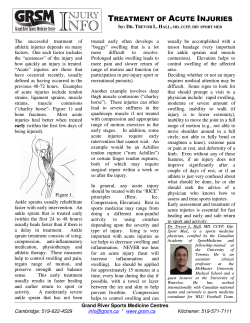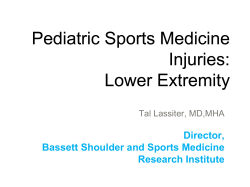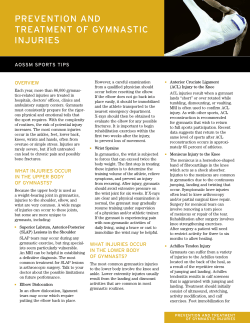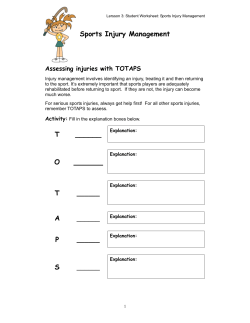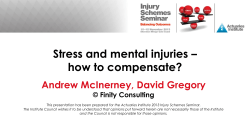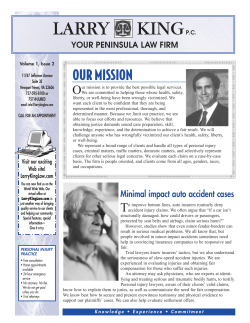
How to avoid your local orthopedic surgeon OR
How to avoid your local orthopedic surgeon OR How to live the athletic life you lead or fantasize that you lead Sabine von Glinski, MD Orthopedic Injuries in Life •Soccer and other youthful/collegiate sports •Recreational Athletic Pursuits •Pregnancy •All of us •Working, working, working: ergonomics • Let’s just get soccer and all of the rest of these sports out of the way: Volleyball Softball Basketball ACL disruption*** Ankle Sprain Cutting & Jumping Sports/injuries • • Females:4-6x more likely have an ACL injury than men • High School Female Athlete: total number 4x higher than above (>40,000 serious knee injuries/yr) Collegiate sports: 1/10 female athletes with ACL injury (>15,000/yr) The ACL Injury of the ACL Mechanism of ACL Injury • • Noncontact injuries = 80% ACL tears Female: Ç vulnerability due to neuromuscular imbalances: • Ligament dominance • Unbalanced quad dominance • Poor landing mechanics: single-legged landing Preseason Prevention Training • • Three Phase Training Program involving • Plyometrics • Strengthening: lower extremity & core • Stretching Focus ↓ ↓ ↑ ↑ Peak landing forces Valgus torque at knee Hamstring function Jump height Prevention Training • Focus and Goals • Avoid vulnerable positions • Increase flexibility • Increase strength • Include plyometric exercises into the training program • Increase proprioception though agilities Prevention Training • This translates to correction of dynamic movement patterns & muscle imbalances ACL Injury Prevention Progams • Santa Monica Sport Medicine Group • www.aclprevent.com • Dr. Tim Hewett • fax: (513) 636-5958 / Email: tim.hewett@cchmc.org • Vermont Ski Association • fax: (802) 229-6917 / Email: info@skivermont.com • Oslo Sports Trauma Research Center • Email: odd-egil.olsen@nih.no Overuse Injuries • • Associated with: • Poor biomechanics and technique • Previous injury Baseline Treatment once Injured: • RICE = Rest Ice Compress Elevation Ankle Sprains – the Universal Injury • • Common to: volleyball, soccer, basketball, softball, runners, triathletes Associated with: • history of previous injury • pronation of hind foot • decreased ankle mobility Prevention of Ankle Sprains • • • • Peroneal muscle conditioning Increase ankle dorsiflexion Improved landing technique: • land with a wide based gait • neuromuscular control of ankle Prophylactic ankle taping or bracing • lace-on stabilizers = better than taping • Semi-rigid plastic braces Running Injuries • • • • • • • • Patellofemoral syndrome Iliotibial band syndrome: +common running downhill Shin splints Stress fractures: +common when running >40mi/wk Ankle sprains Plantar fasciitis Achilles tendonitis: +common if running hills Other tendonitis problems Avoiding Runner’s Injuries • • • • • • • Change shoes every 300-500 miles Select shoes carefully Improve running surface: avoid concrete Select appropriate terrain Stretching: before, after and between runs Taping or bracing: • taping or bracing for PF & ITB syndrome • night splinting for plantar fasciitis Anticipate that age will be a factor Avoiding Runner’s Injuries • • • Minimize muscle imbalance • strengthen hip abductors • strengthen hamstrings Increase training regimen gradually • volume: duration, distance, frequency • intensity: speed, terrain difficulty Improve running biomechanics/ avoid overpronation • decrease muscle imbalances: strengthening exercises • orthotics: OTC (foot soldiers) or custom (orthotist) Overuse Injuries in Triathletes • • • • • Incidence: 45-75% tiathletes rate: 2.5-5.4 injuries/1000 training hours + common cause: training errors • training hours • technique • poor hydration & electrolyte intake + occur during running + involve lower extremity: 72-77% • knee is the most common site: 32% Overuse Injuries in Triathletes Overuse Injuries in Triathletes • +correlations with injuries • History of previous injury • Training hours: too little or too much 2x injury rate • Biking: 5-6hrs/week = best • Running: 3-4 hours/week = best • Total: 8-11 hours/week • Pre-training warm-up & post-training cool down: • None or occasional only Çinjury rate • number of years of triathalon experience • >5 years experience Çinjury rate • Higher Competition level • National level or higher: 2x injury rate Biking Overuse Injuries • • Rare in experienced riders Injuries common in 1st time century riders with the following biking history: <26 miles/week <500 miles/year at speeds <14 miles/hour never biked >30 miles/single ride never biked >100 miles/1 day bought bike <1 year prior to century ride Biking Overuse Injuries • • • • • • • buttock pain – butterfly saddles knee problems - correct riding position, lower gear neck & shoulder pain – correct riding position hand & wrist pain/numbness (CTS) foot or ankle pain - correct riding position tendonitis – contrast baths leg pain and cramping – massage, hydrate, electrolytes Overuse Injuries for Swimmers • • • Otitis media Shoulder pain • Impingement syndrome • Subscapularis bursitis • Instability associated pain: especially in elite, younger swimmers Back pain Overuse Injuries for Swimmers • Prevention shoulder injuries: • Improved back posture in daily life • Improved swimming technique • Prevention of back injuries • Improve kicking biomechanics • Improve breathing technique Pregnancy and Exercise • Safe exercises: • Sedentary women: begin with 15min/3x per week • Eat & drink fluids appropriately • most non-weight bearing exercises • Swimming • Stationary biking • walking • increase as tolerated • follow talk test • after 1st trimester avoid: • supine exercises • exercises involving prolonged standing Pregnancy and Exercise • Active women: • Continue regular exercise regimen • Physical comfort should dictate types&levels of activities • Expect gradual decline in performance throughout pregnancy • Competitive Athletes: • Readjust goals • Maintain basic fitness • Do not attempt to stay at peak performance levels Pregnancy and Exercise • Contact sports • avoid after 1st trimester • Exercise at high altitude • moderate exercise at altitudes up to 6000ft • acclimatize gradually • No scuba diving Women and Lifting Proper biomechanics: squat down bending at the knees (not your waist). Tuck your chin while keeping your back as vertical as possible. The Non-exercising woman • Change this: begin slowly • 15-20 minutes – 3x/week • • • Maintain proper posture Maximize ergonomics at home and at work Avoid obesity Biomechanics and Strengthening • If you belong to a gym: • Treat yourself to a personal trainer • Improve your technique • If you don’t belong to a gym: • Consider a home exercise corner • www.fitter1.com • www.exertools.com • www.kettlebell-training.com • Other internet sources and tapes General Factors that can cause Musculoskeletal Pain • • • Obesity Tobacco use Lack of regular exercise Key Points Cutting & Jumping Sports/injuries •Females:4-6x more likely have an ACL injury than men Prevention Training •Focus and Goals • Avoid vulnerable positions • Increase flexibility • Increase strength • Include plyometric exercises into the training program • Increase proprioception though agilities Key Points Overuse injuries Rest Ice Compress Elevation The Non-exercising woman •Change this: begin slowly • 15-20 minutes – 3x/week •Maintain proper posture •Maximize ergonomics at home and at work •Avoid obesity Resources Home Based Fitness/Equipment www.exertools.com 31 Boulevard Blvd, Suite F Novato, CA 94949 1-800-235-15591559 www.fitter1.com www.kettlebell-training.com www.crossfit.com www.powerathletesmag.com Health Based Websites www.sportsmedicine.about.com www.sportsmedicine.about.com www.physioroom.com ACL Injury Prevention •Santa Monica Sport Medicine Group • www.aclprevent.com •Dr. Tim Hewett • fax: (513) 636-5958 / Email: tim.hewett@cchmc.org •Vermont Ski Association • fax: (802) 229-6917 / Email: info@skivermont.com •Oslo Sports Trauma Research Center • Email: odd-egil.olsen@nih.no Braces, etc. Demar Medical – night braces for plantar fasciitis rcenco@aol.com (925)-285-9461- Rich Belcher Aircast Sport Stirrup DonJoy ALP brace Bicycle Seats Butterfly Seat – Terry Fly models have the best overall ratings Kaiser Permanente Resources For resources tailored just for women, visit kpwomenswellness.org Healthwise® Handbook Members may call 1-800-464-4000 for a free copy Resources for a healthy lifestyle kp.org/healthyliving •Healthy Lifestyle Programs •10,000 Steps program® •Health Classes •Healthy Discounts •Online Drug and Health Encyclopedia •Health Calculators •Featured Health Topics •Message Boards
© Copyright 2025


